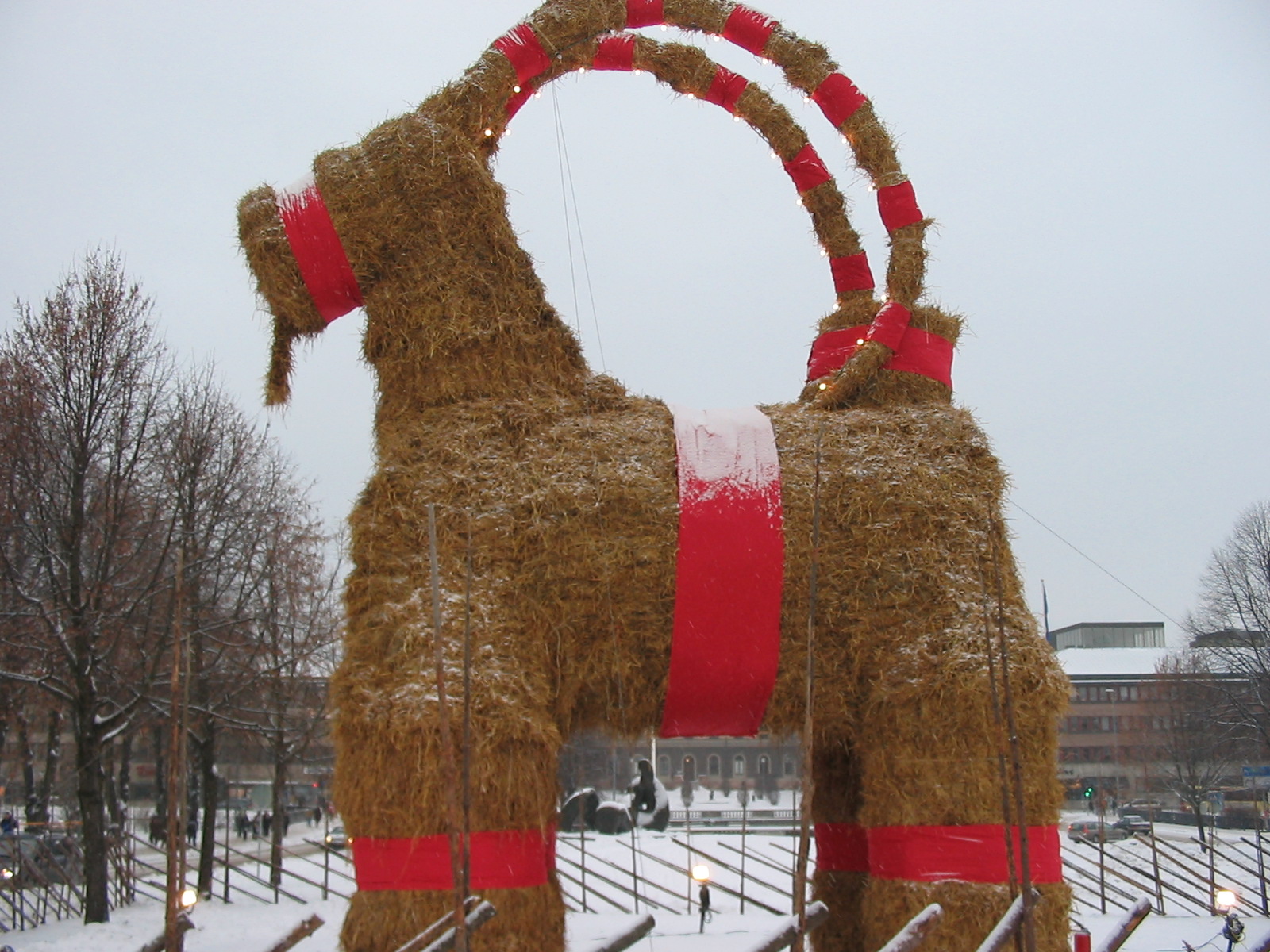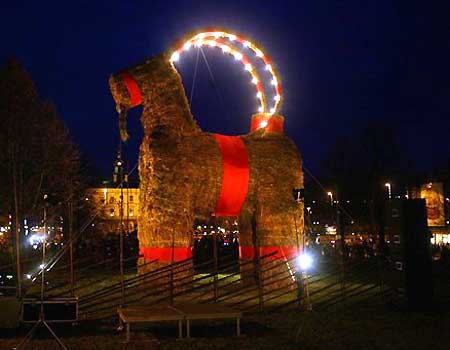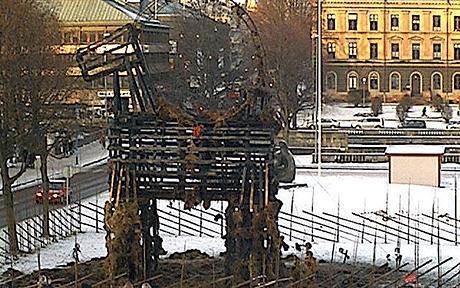Odds seem stacked against Christmas goat
The Swedish city of Gävle has a pair of Christmas traditions that make headlines around the world. Each year, merchants and students build a huge straw Christmas goat and almost every year, someone burns it down.
-
 Looking for a special gift? A gift that will last for a long time? Look at our website under <a href="http://www.nordstjernan.com/subscribe">SUBSCRIBE</a> It will last for as long as you'd like...
Looking for a special gift? A gift that will last for a long time? Look at our website under <a href="http://www.nordstjernan.com/subscribe">SUBSCRIBE</a> It will last for as long as you'd like... -
-
Since when has sodium silicate been a hot Christmas item? Since the city of Gävle, Sweden decided to go all out to prevent arsonists, vandals and drunk teens from torching the massive straw Christmas goat the city erects every year during the yule season.
-
 The Gävle Christmas goat by day ...
The Gävle Christmas goat by day ... -
-
The tradition of the Christmas goat, depending on the source, dates back to the spread of Christianity in Scandinavia or even earlier. Some stories claim the tradition has its roots in the myth of the Norse god Thor. A pair of mighty goats, Tanngrisnir and Tanngjostr, pulled Thor’s chariot through the sky. Other stories say the job of the Yule Goat was to ensure Swedes celebrated Christmas properly.
-
 ... and night
... and night -
Whatever its origins, few Swedish homes can top the treatment Gävle gives its goat. A city of roughly 68,000, located midway up Sweden's east coast, Gävle each year since 1966 builds a huge straw Christmas goat as part of the community Christmas celebration. And, just about each year since 1966, someone—from professional arsonists to kids who had a little too much holiday cheer—burns the goat to the ground.
This year, however, city officials say they aren’t worried about arson or vandalism. In fact, they just about dare anyone to try to burn down their goat. The reason for their confidence is sodium silicate, a flame retardant chemical said to make their goat impervious to fire. -
 The aftermath of the 2007 arson attack: The Gävle goat sits as a burned-out hulk.
The aftermath of the 2007 arson attack: The Gävle goat sits as a burned-out hulk. -
“The best present we could give him is to keep him alive,” city officials wrote on the Gävle kommun Web site. "We have therefore impregnated him with flame retardant chemicals, which will keep him fire proof. We did try this some 10 years ago, but the chemicals were then washed off by the rain. The new chemicals are water and snow proof—and often used in airplanes—so we are very confident that the Gävle Goat will make it this year.”
-
According to the city website, a resident named Stig Gavlen first came up with the idea of building a massive goat in 1966. The plan was to use the goat “to attract customers to the shops and restaurants in the southern part of the town center,” officials said.
-
The first goat went up in flames on New Year’s Eve in 1966 and police arrested and prosecuted “an arsonist.” The next two goats survived unscathed. Starting in 1969, however, the goat became an annual target. Vandals burned it to the ground in 1969, 1970 and 1971. Finally, the merchants that paid for the goat had enough and they backed out of the project. Students from the Vassaskolan raised the money for the next two goats, but again, vandals made sure it never made it past Christmas.
A drunk driver took out the 1976 goat while vandals burned the next three. Starting in 1981, the goat usually never made it to Christmas as vandals burned the straw animal to the ground on St. Lucia Day, Dec. 13, 1982-1986. Still, not even lighter fluid and matches could prevent the goat from making history. -
In 1985, the Guinness Book of World Record officially named the goat the largest straw animal in the world. It didn’t save the goat. Vandals burned it that January. City merchants returned to goat building in 1986 and from that year on, two goats went up in Gävle, with the merchants building the bigger of the two while students from the Vassaskolan constructed a scaled-down version. The thought behind the dual goats was there would always be at least one. That plan, however, failed miserably as vandals torched the bigger one and took gleeful pleasure in hacking off the legs of the smaller one.
-
City officials fought back starting in 1987, when they began to treat the straw with fire retardant chemicals. The treatment didn’t work. Vandals burned the goat the week before Christmas. By now, the construction and burning of the goat was international news. British betting houses began offering odds on whether and for how long the goat would survive starting in 1988.
-
This year (2009), oddsmakers still favor the bad guys. According to pinnaclesports.com, a British betting house, chances of the goat going up in flames are 2-3, meaning a bettor would have to wager $3 to win $2. The house set the odds of the goat surviving at 7-5.
-
The 1992 goat went through three lives and all three ended in flames. Vandals burned the first big goat eight days after construction, torched the smaller student-built goat the same day and then burned a second big goat the merchants built on Dec. 20. This time, police arrested the arsonist.
-
The goat again made the Guinness Book of World Records in 1993 when the student goat reached a height of 16 meters, about 55 feet. It managed to survive in 1993 and 1994 but in 1995, the year of the city’s 550th anniversary, it burned.
-
Arguably the oddest arsonist to torch was Lawrence Jones, a 51-year-old man from Cleveland, Ohio, who burned the goat down in 2001. Jones torched the goat on Dec. 23 but police caught him and a court convicted him. He spent 18 days in jail for his crime.
-
Since then, the goat has managed to survive four times in nine years. Twice, in 2003 and 2005, arsonists destroyed the goat well before Christmas, only to see the merchants and students combine to rebuild it.
The 2007 goat survived several attacks thanks to flame retardant chemicals but last year, the maker of the straw, Mackmyra Whiskey, failed to treat its product and vandals burned it to ashes. -
This year, not only has the city made sure about flame retardant chemicals, but it is monitoring the goat around the clock with Web cams, police patrols and a small army of volunteers. Officials say, "not even napalm could burn down the goat this year."
-
Still, if the British bookies are correct, whether the goat manages to survive the entire Christmas season might just be a long shot.
-
Compiled by Chipp Reid
-
For continuous updates and links to images and film, see www.visitgavle.se/sv/gavlebocken Gävlebocken also tweets: www.twitter.com/Gavlebocken
-
-
